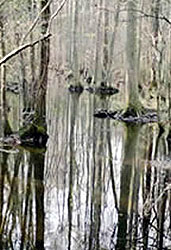
Department of the Interior officials today dedicated the Great Dismal Swamp National Wildlife Refuge as a site, or station, on the historic Underground Railroad, the hidden network of people and places that provided refuge for African-American slaves on their long journey to freedom.
The Great Dismal Swamp refuge is the first national wildlife refuge to be included in the National Underground Railroad Network to Freedom Program administered by the National Park Service.
"As we commemorate Black History month, it is appropriate that we remember the courage and determination of both African-Americans who escaped from slavery and of those of all races who risked their lives to help them in places like the Great Dismal Swamp," said Assistant Secretary of the Interior Craig Manson. "The Underground Railroad was a first step in a long journey toward freedom, justice and opportunity for African-Americans."
Four other Great Dismal Swamp sites outside of the refuge were also dedicated as part of the Underground Railroad program, including the Dismal Swamp Canal, North Carolina's Dismal Swamp State Park, Dismal Swamp Canal Welcome Center and Elizabeth State University's Dismal Swamp Boardwalk.
The swamp, which straddles the border between Virginia and North Carolina, offered runaway slaves an opportunity to purchase their freedom by either working on the Great Dismal Swamp canal or by producing shingles and timber from cypress trees. Others found refuge deep in the swamp, living off the land as best they could. The swamp also served as a stopping point on the road to nearby ports where passage could be secured on ships traveling north.
During the Civil War, Union Army regiments of the United States Colored Troops under Brig. Gen. Augustus Wild marched down the Great Swamp Canal bank from Deep Creek, Virginia to northeastern North Carolina to liberate and recruit enslaved African Americans.
Descendents of Moses Grandy, a slave who helped construct the Great Swamp Canal, were in attendance at the ceremony today in Chesapeake, Virginia.